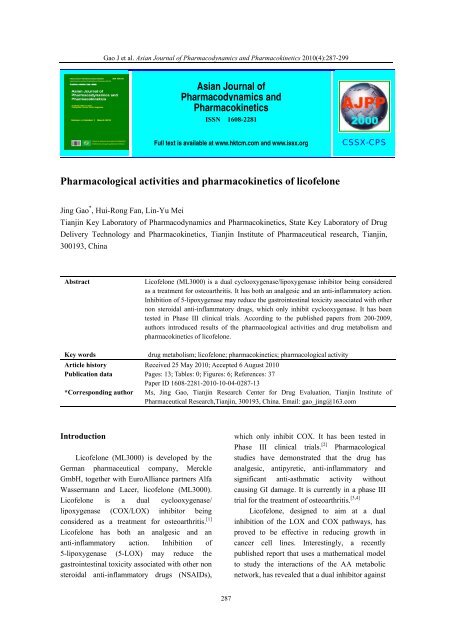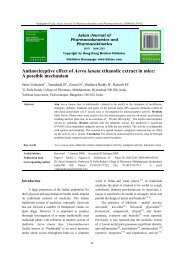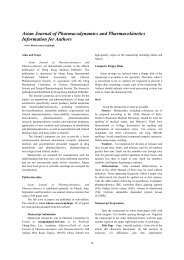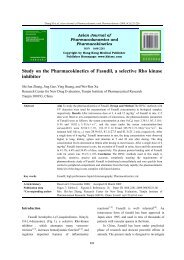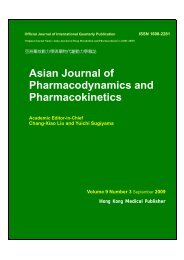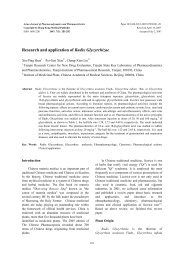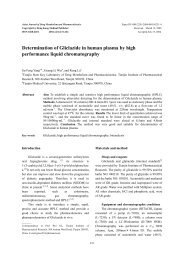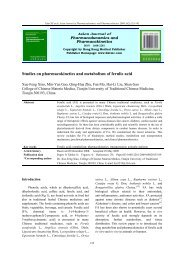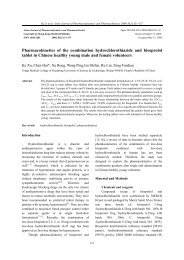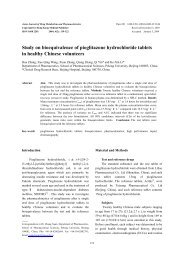Asian Journal of Pharmacodynamics and Pharmacokinetics ...
Asian Journal of Pharmacodynamics and Pharmacokinetics ...
Asian Journal of Pharmacodynamics and Pharmacokinetics ...
You also want an ePaper? Increase the reach of your titles
YUMPU automatically turns print PDFs into web optimized ePapers that Google loves.
Gao J et al. <strong>Asian</strong> <strong>Journal</strong> <strong>of</strong> <strong>Pharmacodynamics</strong> <strong>and</strong> <strong>Pharmacokinetics</strong> 2010(4):287-299hydroxylation <strong>and</strong> glucuronidation reactions,were performed, <strong>and</strong> the metabolic pathway <strong>of</strong>lic<strong>of</strong>elone was elucidated. After glucuronidation,predominantly catalyzed by UDPglucuronosyltransferase (UGT) is<strong>of</strong>ormsUGT2B7, UGT1A9, <strong>and</strong> UGT1A3, M1 isconverted into the hydroxy-glucuronide M3 in aCYP2C8-dependent reaction. The enzymespecificities were investigated using recombinanthuman cytochrome P450 <strong>and</strong> UGT is<strong>of</strong>orms astest systems. In vitro drug-interaction studiesusing the 6α-hydroxylation <strong>of</strong> paclitaxel ascontrol reaction confirmed that neither lic<strong>of</strong>elonenor M1 is a relevant inhibitor <strong>of</strong> CYP2C8. Theformation <strong>of</strong> M3 was also observed with livermicrosomes from cynomolgus monkeys, but inincubations with mouse <strong>and</strong> rat liver microsomes,M1 remained unchanged. [9]Biotransformation pathwayIn conventional in vitro assays using livermicrosomes <strong>and</strong> NADPH as cosubstrate, a highmetabolic stability <strong>of</strong> lic<strong>of</strong>elone was observed. Incontrast, M1 remained at the level <strong>of</strong> a tracemetabolite. In that respect, the disposition <strong>of</strong>lic<strong>of</strong>elone in humans is different from all thest<strong>and</strong>ard animal species (mouse, rat, dog, monkey)in which systemic concentrations <strong>of</strong> M2 werenegligible even on chronic dosing. A furtherhydroxy-metabolite <strong>of</strong> lic<strong>of</strong>elone is M4. Thiscompound was initially identified in microsomalexperiments but not in plasma samples fromhumans after single <strong>and</strong> repeated administration <strong>of</strong>therapeutic doses (i.e., 200 or 400 mg b.i.d.).Relevant concentrations were determined in plasmasamples from subjects who were treated withincreasing doses to determine the maximumtolerated dose. The chemical structures <strong>of</strong>lic<strong>of</strong>elone <strong>and</strong> its metabolites are shown in Fig.1.Fig 1. Chemical structure <strong>of</strong> lic<strong>of</strong>elone <strong>and</strong> its proposed biotransformation pathway.The results from in vitro metabolism studiesshow that in humans hydroxylation <strong>of</strong> theglucuronide M1 represents the pivotal step in thebiosynthesis <strong>of</strong> M2. [9] Although the cytochromeP450 (P450)-dependent hydroxylation <strong>of</strong>glucuronides has been described in theliterature. [34,35] The formation <strong>of</strong> M2 represents aunique example as the systemic exposure <strong>of</strong>humans to this major metabolite is based on theglucuronidation <strong>of</strong> the parent drug followed byhydroxylation <strong>of</strong> the glucuronide.In the presence <strong>of</strong> UDPglucuronic acid,lic<strong>of</strong>elone is rapidly converted into thecorresponding acyl glucuronide, M1. These resultsare in conflict with data from clinical studies. Afteradministration <strong>of</strong> lic<strong>of</strong>elone to humans, M1 plasmaconcentrations were negligibly low, whereas theexposure <strong>of</strong> the hydroxy-metabolite M2 achieved293
Gao J et al. <strong>Asian</strong> <strong>Journal</strong> <strong>of</strong> <strong>Pharmacodynamics</strong> <strong>and</strong> <strong>Pharmacokinetics</strong> 2010(4):287-299The whole-body autoradiograms (Fig 6)metabolic capacity <strong>of</strong> hepatocytes does not allowurine(Fig 5). [36] characteristics with a rapid initial decrease <strong>of</strong>the elucidation <strong>of</strong> metabolic pathways. Furthermore,this test system is less suitable to identify theenzymes responsible for biotransformations <strong>of</strong>interest. Finally, hepatocytes from dogs, mice, ormonkeys are not ubiquitously available, whichlimits their use for interspecies comparison <strong>of</strong> drugmetabolism. [9]In Fig. 3, the biotransformation rates, relative tothe initial substrate concentrations, <strong>and</strong> theshow that an a increased radioactivity is left inthe stomach, the highest tissue level is deterctedin the lung, liver, kidneys, heart, large intestine<strong>and</strong> small intestine(Fig 6); the tissue levelscumulation <strong>of</strong> radioactivity is also seen in thespleen, levels in the lung, liver <strong>and</strong> kidneys arelower relative to the intestine levels (Fig 6b); <strong>and</strong>at 48 h, the tissue distribution is similar to theresult obtained affer 24 h (Fig 6c).concentrations are given. With 10 <strong>and</strong> 30 µmollic<strong>of</strong>elone, the sum <strong>of</strong> glucuronides (M1 < M3) was3.41 <strong>and</strong> 9.92µmol, which correspond tobiotransformation rates <strong>of</strong> 34 <strong>and</strong> 33%. With 100µl <strong>of</strong> lic<strong>of</strong>elone, the relative glucuronide contentwas 25%. The biotransformation rate <strong>of</strong> M2 <strong>and</strong>M3 decreased with ascending substrateconcentrations. The highest M3 concentration (5.02± 0.11 µmol) was observed at 30 µmol, whereasonly 2.41 ± 0.56µmol was determined afterincubation <strong>of</strong> 100 µmol lic<strong>of</strong>elone. These dataindicate that the glucuronidation capacity <strong>of</strong> the testsystem was limited at concentrations greater thanFig 4. Plasma level <strong>of</strong> rasdioactivity <strong>of</strong> 14C-ML3000after oral administration <strong>of</strong> a single dose 28.6 mg.kg -1to rats.30 µM. In contrast, hydroxylation <strong>of</strong> M1 was partlyinhibited in incubations with 100 µmol. M4concentrations increased with ascending substrateconcentrations in an almost proportional manner.The biotransformation rate to M4 was essentiallyconstant. [9]<strong>Pharmacokinetics</strong> in animalsPlasma levels <strong>and</strong> distribution <strong>of</strong>radioactivity were examined using whole-bodyautoradiography after oral administration <strong>of</strong>14 C-labeled lic<strong>of</strong>elone (13.7 to 28.6 mg·kg -1 ) t<strong>of</strong>emale rats (Fig 4). Plasma levels <strong>of</strong> lic<strong>of</strong>eloneFig 5. Excretion <strong>of</strong> radioactivuy with feces(-) <strong>and</strong> urine(---) after oral administration <strong>of</strong> 28.6 mg.kg -1 dose.peaked at 3 to 4 h after administration, with aplasma t 1/2 <strong>of</strong> about 11 h. The highest tissuelevels <strong>of</strong> lic<strong>of</strong>elone were detected in the lung,liver, kidney, heart <strong>and</strong> intestine. Almost nopenetration <strong>of</strong> the blood-brain barrier was noted;however, after 48 h there was a minoraccumulation in fat. Of the total radioactivity,<strong>Pharmacokinetics</strong> in humansIn humans, after p.o. administration <strong>of</strong>immediate-release tablets, lic<strong>of</strong>elone is rapidlyabsorbed from the gastrointestinal tract, <strong>and</strong>maximum plasma concentrations are achievedapproximately 2 to 3 h after administration.58.3% was found in the feces <strong>and</strong> 7.9% in the Systemic elimination follows biphasicplasma concentration [T ½α = 1 h] <strong>and</strong> a slow296


